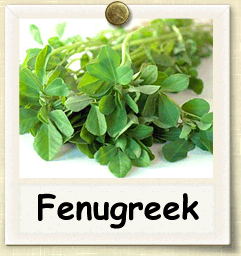|
Home > Guides > Herbs > Fenugreek |
|
How to Grow Fenugreek | Guide to Growing Fenugreek |
|
|
|
|
| |
 |
|
Overview |
|
|
|
|
|
| |
|
| |
Fenugreek has traditionally been used in the preparation of pickles, chutneys and curry powders in its native India, where is has been used as a nutty and slightly bitter culinary seasoning for thousands of years. While the seeds are the most known and commonly used part of the plant, fresh Fenugreek leaves can make a flavor addition to salads or other raw dishes or dried and used with meat or poultry. |
|
| |
|
|
| |
Growing Guide
GROWING NOTES
Fenugreek will grow up to 2' tall, and will display pale yellow and white flowers from midsummer on.
Fenugreek is best started 4-6 weeks indoors prior to the last frost of the season. Seeds should be sown 1/4" deep in a lightweight medium and keep well-moistened. Moderate water slightly once seeds start to germinate. Fenugreek is a legume, and may not be very tolerant to the disturbance after germination. To minimize this, sow seeds in biodegradable pots that can be transplanted directly into the ground later.
MAINTAINING
Transplant outdoors after the final frost of the season has passed, ideally on an overcast day.
Fenugreek should be grown in full sun to part shade or filtered sunlight. For best results, sow in well-drained, loamy, slightly acidic (pH 6.5) soil.
|
|
| |
|
| |
Heirloom seeds are the gardeners choice for seed-saving from year-to-year. Learning to save seeds is easy and fun with these books. Before you harvest, consider which varieties you might want to save seeds from so that your harvesting practice includes plants chosen for seed saving. Be sure to check out our newest seed packs, available now from Heirloom Organics. The Super Food Garden is the most nutrient dense garden you can build and everything you need is right here in one pack. The Genesis Garden s a very popular Bible Garden collection. The Three Sisters Garden was the first example of companion planting in Native American culture. See all of our brand-new seed pack offerings in our store.
|
|
| |
|
|
| |
Harvesting Guide
HARVESTING
The seed pods should be collected in fall. They can be dried after collection on screens and turned over as needed. To extract the seeds, the pods can be threshed and the seeds separated from the chaff by winnowing.
SAVING SEEDS
Seeds can be collected in same manner as with harvesting. Store in a sealed container in a dry, cool location out of direct sunlight for optimum life.
|
|
| |
|
|
|
| |
|
|
|
|
|
| You can find this variety in the following Seed Packs: |
|
 |
|
| Click the packs below to see some of our other wonderful products |
|
|
|
|
|
|
|